Discover the Hidden Beauty of VIETNAM
Read moreEpic travel adventures that linger in your heart
Read more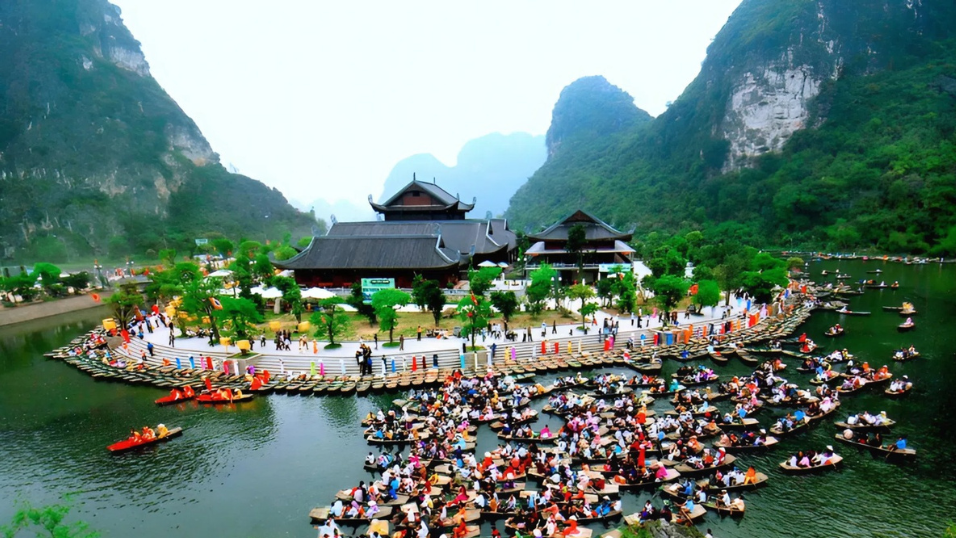 7 July, 2025 0 Comment 434 Views
7 July, 2025 0 Comment 434 ViewsNinh Binh in August: Weather Guide & Travel Tips from Locals
Visiting Ninh Binh in August offers a unique experience of northern Vietnam’s countryside at its greenest. Known for limestone mountains, peaceful rivers, and ancient temples, Ninh Binh is especially lush this time of year. While August is part of the rainy season, the rainfall is usually short and manageable. With fewer crowds and vivid landscapes, it’s a great time for nature and culture lovers to explore. Here’s what to expect and how to make the most of your trip.
1. What to Expect When Visiting Ninh Binh in August
1.1. What’s the Weather Like in Ninh Binh in August?
August in Ninh Binh is part of the late summer and rainy season, bringing a mix of warm sunshine, high humidity, and frequent rain showers. While it’s not the driest time of year, the rainfall is often short and refreshing, typically falling in the afternoon or evening. The mornings are usually dry and calm, ideal for sightseeing and outdoor exploration.
The rain enhances the natural beauty of Ninh Binh, from the lush rice paddies of Tam Coc to the limestone mountains surrounding Trang An. The dramatic contrast between grey skies and bright green fields gives the region a mystical, almost cinematic feel. August may not offer constant sunshine, but it delivers a tranquil and immersive countryside experience. Check out Top 10 Things to Do in Ninh Binh Vietnam Guide by Local Experts for the best visit there.
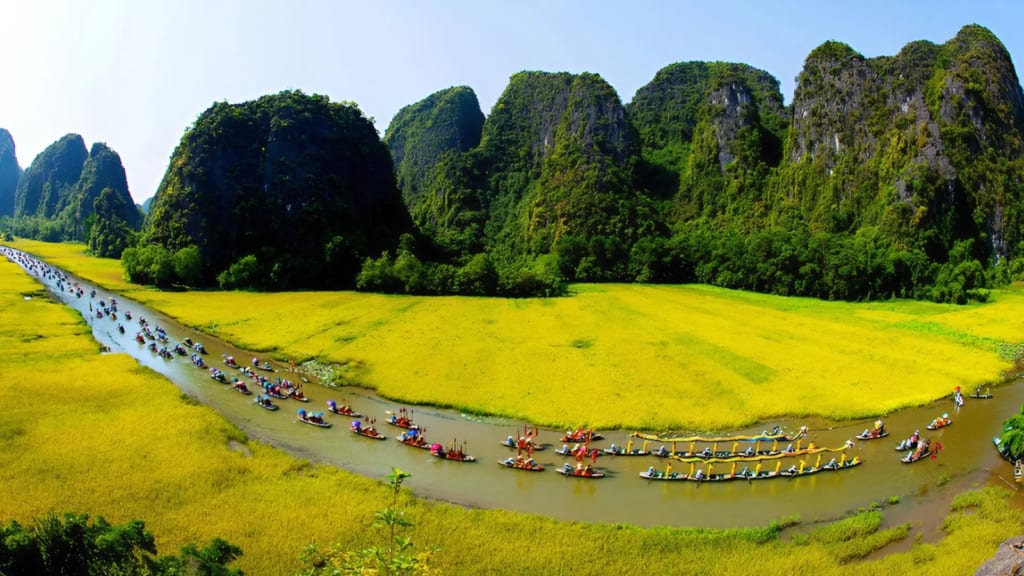
August in Ninh Binh is late summer with warm weather, high humidity, and frequent rain showers. 1.2. Detailed Weather of Ninh Binh in August
- Average Temperature: Temperatures in August typically range from 26°C to 33°C (79°F to 91°F). The heat is noticeable during midday, but rain and overcast skies often bring relief later in the day.
- Humidity: Humidity levels remain high, around 80–90%. While the air can feel heavy, the moisture contributes to the region’s rich greenery and healthy wetlands, especially around Van Long Nature Reserve.
- Rainfall: Rain is frequent but brief. Expect sudden downpours rather than all-day rain. Most outdoor activities can still go ahead with some schedule flexibility. The rain refreshes the air and enhances the colors of the landscape.
- Sky Conditions: Skies are partly cloudy on most days. While full sun may be rare, the softer light makes it easier to explore and photograph Ninh Binh’s scenic routes without harsh glare.
1.3. Is August a Good Time to Visit Ninh Binh?
Whether or not August is the best time to visit Ninh Binh depends on your travel priorities. If you're looking for quiet, nature, and authenticity, August is a great choice. It’s the off-season for international tourism, which means fewer crowds at popular spots like Hoa Lu Ancient Capital or Mua Cave. Accommodation prices may also be lower.
The rice fields in many areas are still green or in harvest transition, creating fantastic scenery for boat rides in Tam Coc or trekking near Bai Dinh Pagoda. While occasional rain may disrupt some outdoor activities, most can still be enjoyed with good planning.
Why Visit Ninh Binh in August:
- Less crowded tourist sites
- Lush, vibrant landscapes and dramatic limestone formations
- Cooler evenings after the rain
- More local, authentic experiences due to lower tourist flow
- Ideal conditions for photography in misty, reflective lighting
What to Watch Out For:
- Rain may cause delays for biking or hiking trips
- High humidity can be uncomfortable for some travelers
- Boat rides may be canceled temporarily during heavy downpours
For more insights on weather conditions to prepare your travel well, check our Complete Guide for Best Time to Go to Ninh Binh Vietnam by local experts.
1.4. Who Should Visit Ninh Binh in August?
Ninh Binh in August is best suited for travelers who enjoy nature, culture, and slow-paced exploration. It may not be ideal for those expecting dry, beach-style weather, but offers a refreshing contrast for those seeking a quieter travel experience.
- Nature Enthusiasts and Photographers:
The combination of rain-washed landscapes, misty mountains, and reflective river scenes creates perfect conditions for photography and nature walks. - Cultural Travelers:
With fewer crowds, places like Hoa Lu Ancient Capital, Bich Dong Pagoda, and Bai Dinh Pagoda feel more atmospheric and peaceful. - Budget-Conscious Travelers:
August is outside peak tourist season, so accommodations and tours are often more affordable while offering the same quality of experience. - Couples and Slow Travelers:
The quiet, romantic scenery of Ninh Binh makes it ideal for those looking to relax, connect with nature, or enjoy a slower travel rhythm.
2. Top Things to Do in Ninh Binh in August
2.1. Take a Boat Ride Through Tam Coc or Trang An Early in the Morning
A boat ride through the rice paddies and limestone valleys of Tam Coc or the cave-studded waterways of Trang An Scenic Landscape Complex is the highlight of any trip to Ninh Binh. In August, early mornings offer the best experience: cooler air, soft light, and peaceful scenes with fewer boats on the water.
After a rain, the mist rising from the cliffs and the calm reflection of the karst peaks on the water create a magical, almost surreal experience. The lotus flowers are also in bloom along parts of the river, adding to the scenery.
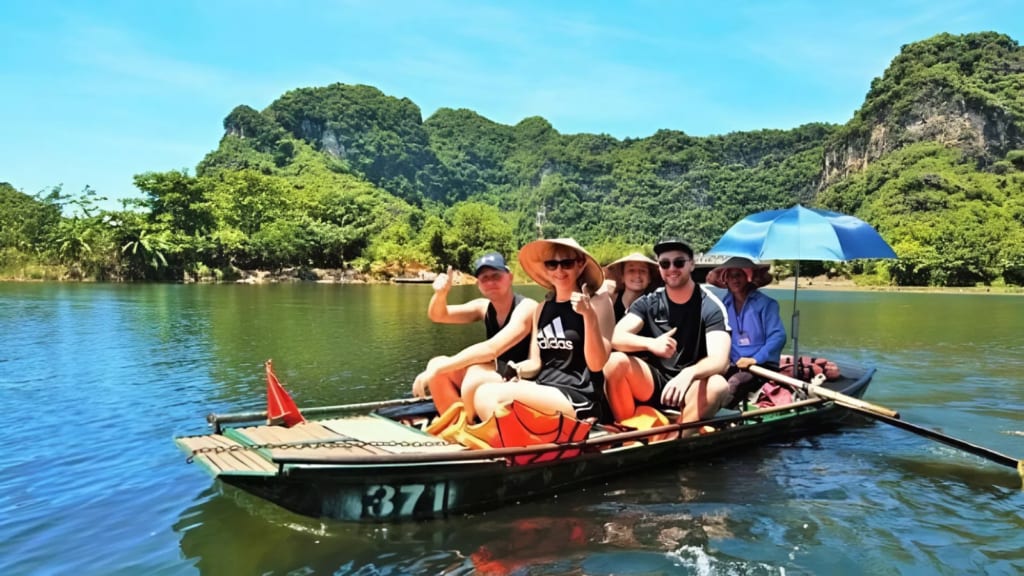
A boat ride through Trang An’s caves and calm waters is a must-do in Ninh Binh. 2.2. Hike to the Top of Mua Cave Viewpoint for Panoramic Views
Mua Cave offers one of the most iconic panoramic views in Vietnam. After climbing nearly 500 stone steps, you’ll reach a viewpoint overlooking the Ngo Dong River and Tam Coc valley. In August, the post-rain scenery is especially dramatic: bright green rice fields stretch below, and the limestone peaks rise through the clouds.
The hike is best done in the early morning or late afternoon to avoid the midday heat and humidity.
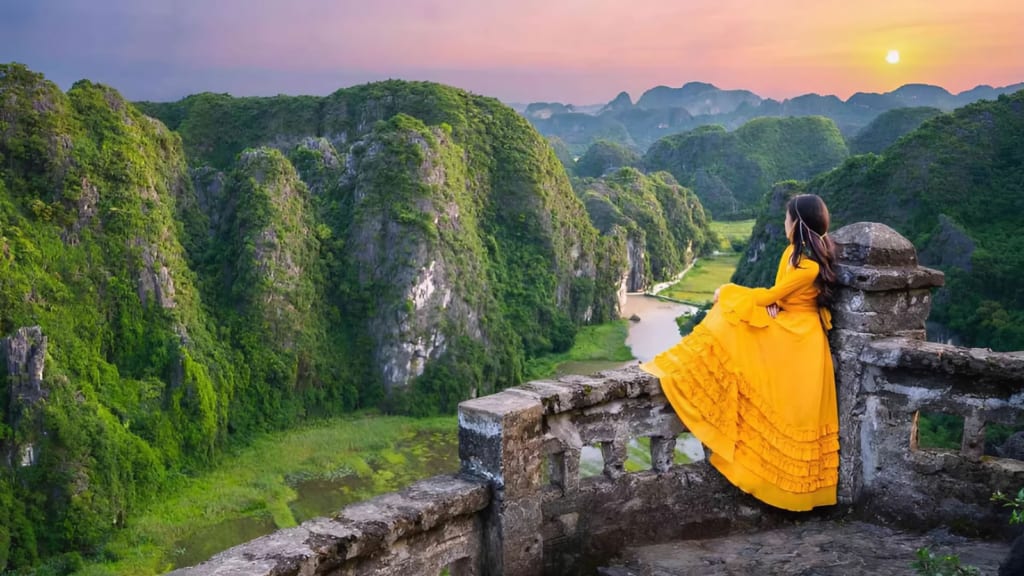
Mua Cave offers one of the most iconic panoramic views in Vietnam. 2.3. Explore Ancient Temples at Hoa Lu Ancient Capital
Located in a peaceful valley surrounded by mountains, Hoa Lu was once the capital of Vietnam in the 10th and 11th centuries. Today, visitors can walk among the remaining temples, gates, and shrines dedicated to former kings Dinh Tien Hoang and Le Dai Hanh.
In August, the gardens and courtyards of Hoa Lu are green and quiet, with fewer tour groups. It’s a great place to learn about early Vietnamese history and enjoy traditional architecture in a tranquil setting.
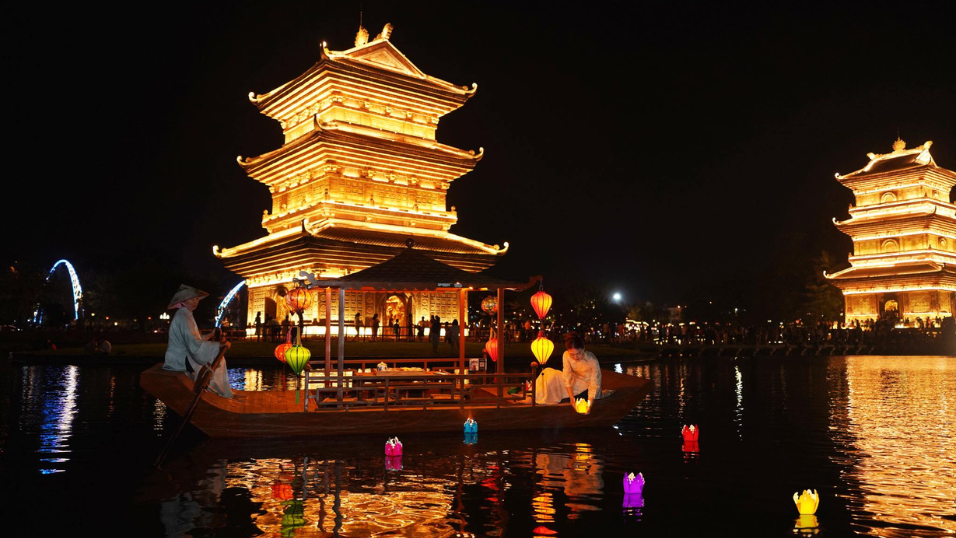
Hoa Lu, a quiet valley surrounded by mountains, was Vietnam’s capital in the 10th-11th centuries. 2.4. Visit Bai Dinh Pagoda on a Cloudy Afternoon
Bai Dinh Pagoda, one of the largest Buddhist complexes in Southeast Asia, is especially atmospheric under overcast skies. The scale of the temples, massive Buddha statues, and sweeping views of the mountains are impressive in any season, but the cloud-filtered light in August gives the site a calm and spiritual feel.
The walk through the long corridors of stone statues provides a peaceful break from the sun and a meaningful cultural experience.
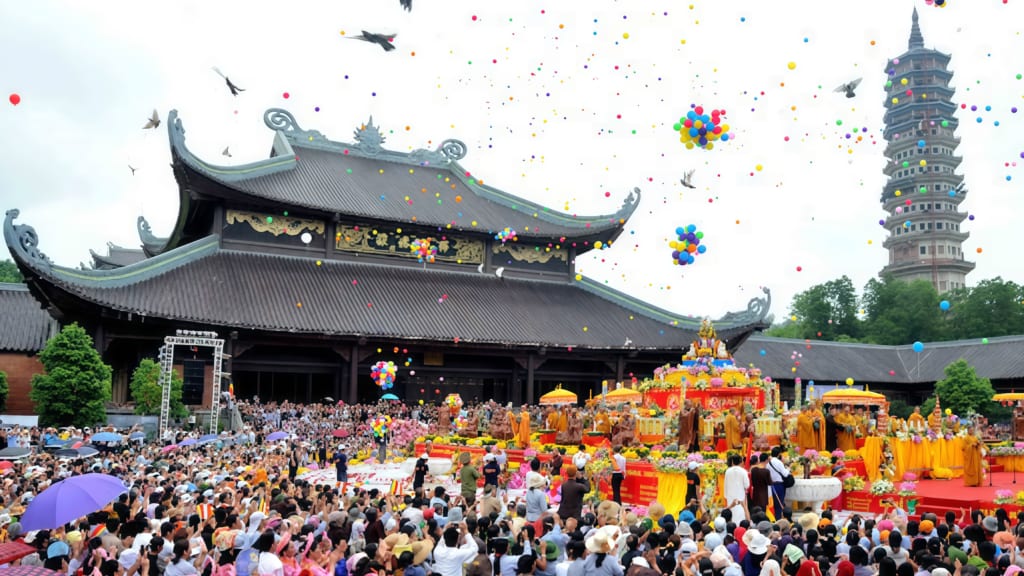
Bai Dinh Pagoda, one of the largest Buddhist complexes in Southeast Asia 2.5. Try Local Cuisine and Enjoy Countryside Dining
August’s rainy afternoons are a perfect time to explore Ninh Binh’s local food scene. Dishes like goat meat with elderberry leaves (dê tái chanh), crispy rice (cơm cháy), and fresh mountain vegetables are best enjoyed in local garden-style restaurants around Gia Vien District or along the roads leading to Tam Coc.
Many restaurants have open-air seating under tiled roofs, allowing you to enjoy the breeze and watch the rain while savoring regional specialties.
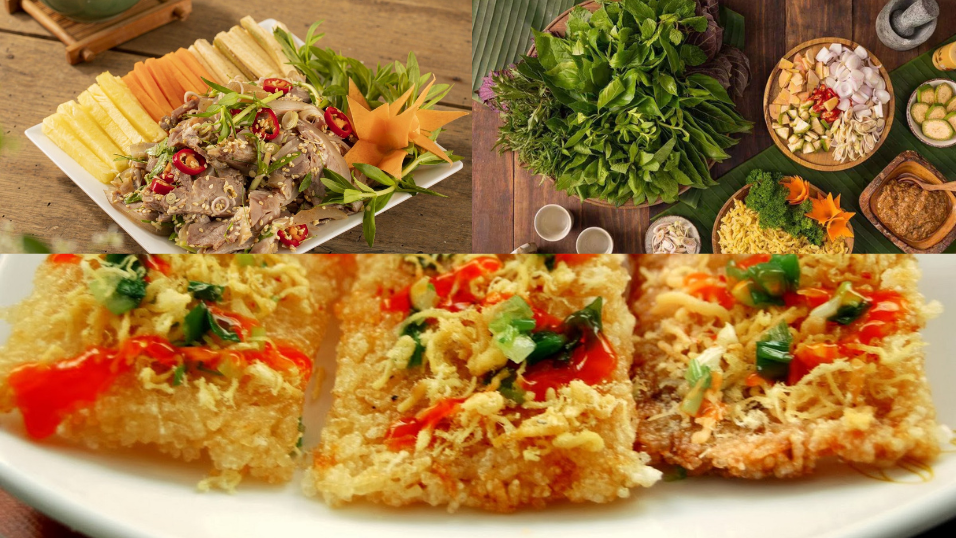
August’s rainy afternoons are a perfect time to explore Ninh Binh’s local food scene. 2.6. Cycle Through Rural Villages Between the Rains
Biking through the villages and rice fields of Ninh Hai or Van Lam Village offers a closer look at daily rural life. Small backroads wind through rice paddies, alongside rivers, and past water buffalo grazing near limestone cliffs. In August, everything is lush and alive.
Just check the weather forecast, and plan short rides between showers. Locals are friendly and often happy to chat or share a drink at roadside tea stalls.
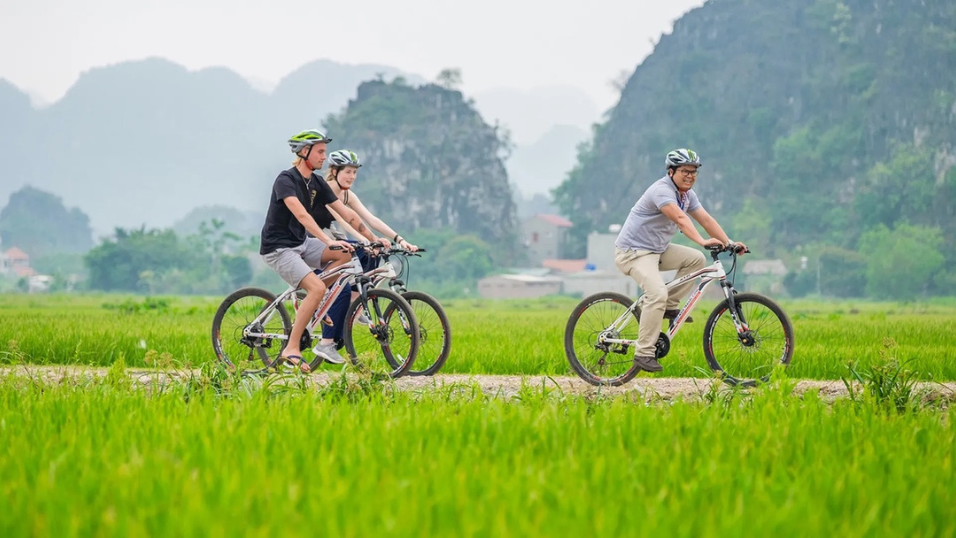
Biking through Ninh Hai or Van Lam lets you glimpse everyday rural life. 3. Best Travel Tips for Ninh Binh in August
To enjoy Ninh Binh in August comfortably and safely, a few simple tips can make your experience smoother and more enjoyable:
- Dress smart for tropical weather:
Wear lightweight, breathable clothing that dries quickly. Bring a compact rain jacket or umbrella, and wear waterproof footwear if you plan on biking or walking in rural areas. - Start your day early:
Most outdoor attractions like boat rides, hikes, and temple visits are best enjoyed in the early morning when the weather is cooler and skies are clearer. - Plan a flexible itinerary:
August weather can change quickly. Rain is usually short but strong. Keep indoor options like pagodas, museums, or restaurants in mind in case of a sudden downpour. - Stay hydrated and take breaks:
High humidity and heat can be tiring. Bring a reusable water bottle, take shade breaks when possible, and avoid hiking or cycling under the midday sun. - Use local guides when possible:
A knowledgeable guide can enrich your visit with history, local customs, and cultural stories, especially at places like Hoa Lu or Bai Dinh Pagoda. - Respect local customs:
When visiting temples or villages, dress modestly (covered shoulders and knees), and be mindful of local traditions and quiet environments.
Explore Ninh Binh with Local Experts
For travelers who want to experience the best of Ninh Binh in August, we, as local experts, offer a variety of well-designed tours, both group and private, tailored to weather conditions and personal interests. Whether you're looking to explore caves by boat, hike to panoramic viewpoints, or cycle through rice fields, our experienced guides will help you uncover the authentic side of Ninh Binh.
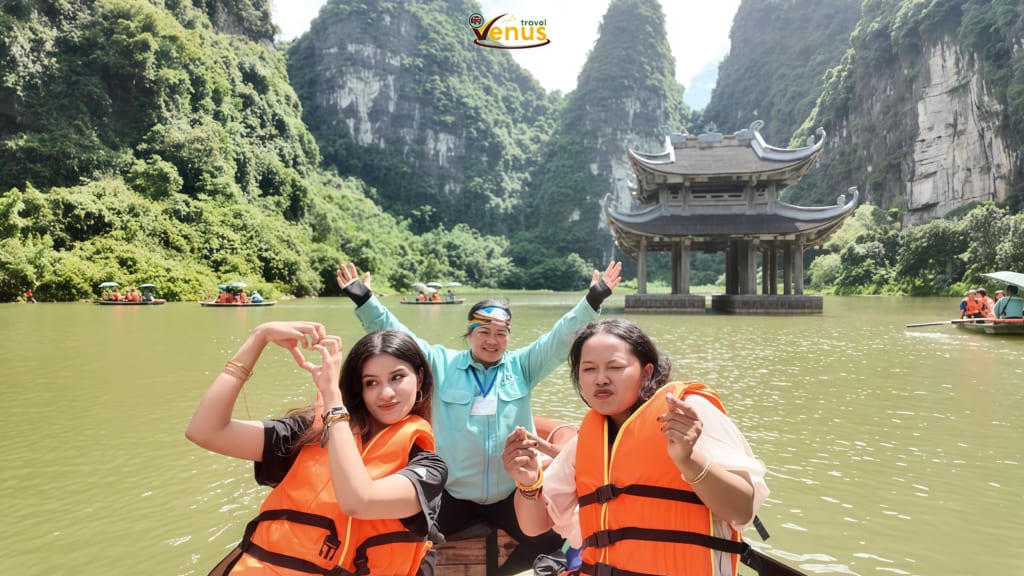
Our traveler was excited and all smiles on Venus Travel’s daily Ninh Binh tour. With thousands of positive reviews from international guests, Venus Travel is proud to provide meaningful, organized, and enriching journeys that reveal the true beauty of Vietnam’s hidden landscapes.
Need help planning your Ninh Binh itinerary or want a custom tour?
Feel free to reach out to us anytime, our local team is available 24/7 with honest advice, personalized support, and the latest travel updates. Follow us for more travel tips and insider experiences across Vietnam!- Office 1: 14 An Nhon 10, Da Nang City, Vietnam
- Office 2: 429A Cua Dai St, Hoi An City, Viet Nam
- Email: venustravelvietnam@gmail.com
- Instagram/Youtube/Tiktok/Facebook: venustravel_vietnam
- Website: www.venusvietnamtravel.com
- Travelers' Choice in 2024 on Tripadvisor: https://www.tripadvisor.com.vn/Attraction_Review-g298082-d12261731-Reviews-Venus_Travel-Hoi_An_Quang_Nam_Province.html
- Top Rated on GetYourGuide: www.getyourguide.com/s/?q=supplier:87597
- Whatsapp/Zalo/Viber: (+84) 905 775 088 (English)/ (+84) 964 056 190 (Chinese)
0 0 votesGuide0 0 votesValue For Money0 0 votesOrganization0 0 votesServiceSubscribe0 FeedbackOldestNewest Most VotedInline FeedbacksView all commentsRecent Post
- Mui Ne in September: Weather, Best Things to Do & Local Tips
- Cu Chi Tunnels in September: Weather, Best Activities & Tips
- Dalat in September: Weather, Activities & Travel Tips by Locals
- Ha Giang Loop in September: Weather, Activities and Local Tips
- Hoi An in September: Weather, Top Things to Do and Local Tips
Tag
Related tours
Vietnam Signature 14 days trip
14 Days From $1012 / person 4.8(236)AFTERNOON BA NA HILLS – GOLDEN BRIDGE & DRAGON BRIDGE BY NIGHT TOUR
Full Day From $68 / person 5()Marble Mountains – Hoi An Ancient Town Morning Tour (Private tour)
Half Day From $0 / person 4.8(236)Ha Noi – Halong Bay – Ninh Binh (Hoa Lu – Tam Coc)
5 Days From $0 / person 4.8(236)Halong Bay Full-Day Deluxe Trip
Full Day From $59 / person 4.8(236)Same Category
Cat Ba in September: Weather Guide, Activities & Local Tips
0 Comment 25 Views
Mui Ne in September: Weather, Best Things to Do & Local Tips
0 Comment 126 Views
Cu Chi Tunnels in September: Weather, Best Activities & Tips
0 Comment 73 Views
Dalat in September: Weather, Activities & Travel Tips by Locals
0 Comment 360 Views
Ha Giang Loop in September: Weather, Activities and Local Tips
0 Comment 240 Views
AFTERNOON BA NA HILLS – GOLDEN BRIDGE & DRAGON BRIDGE BY NIGHT TOUR
0 Comment 0 Views
